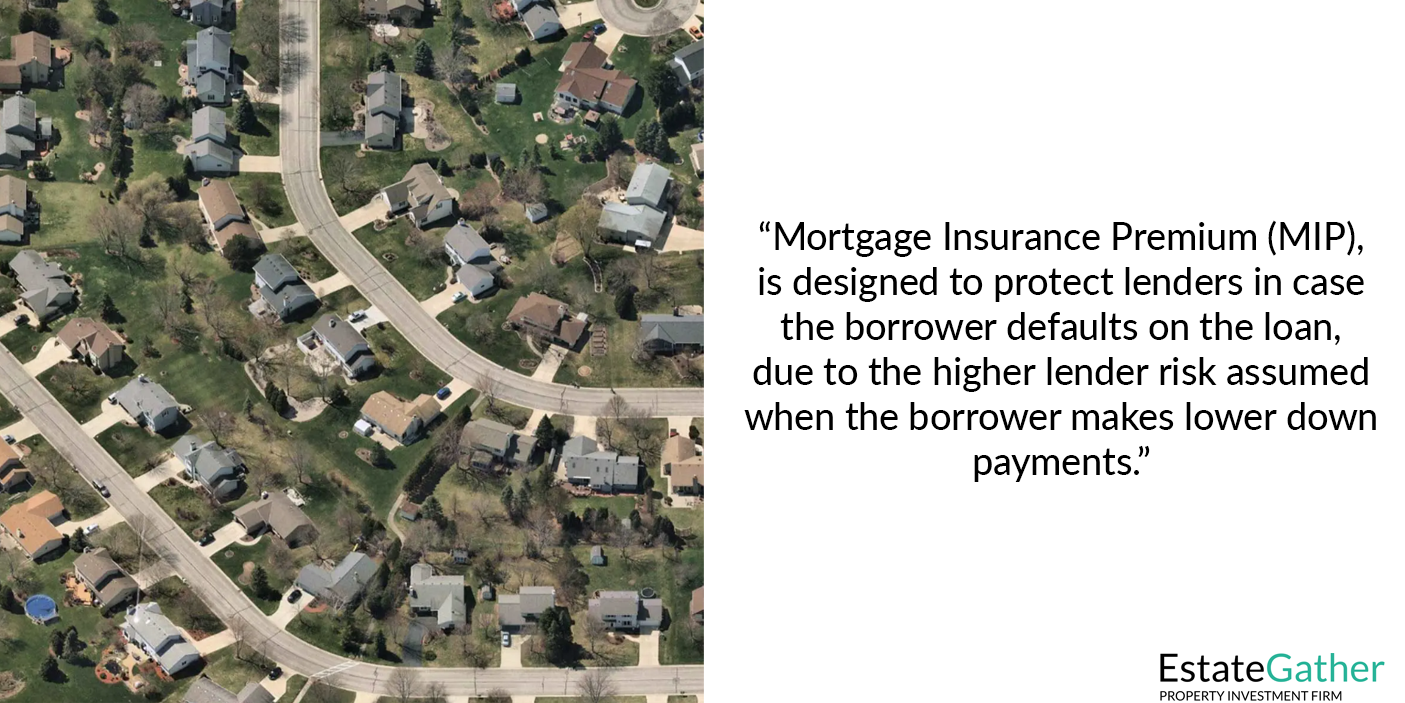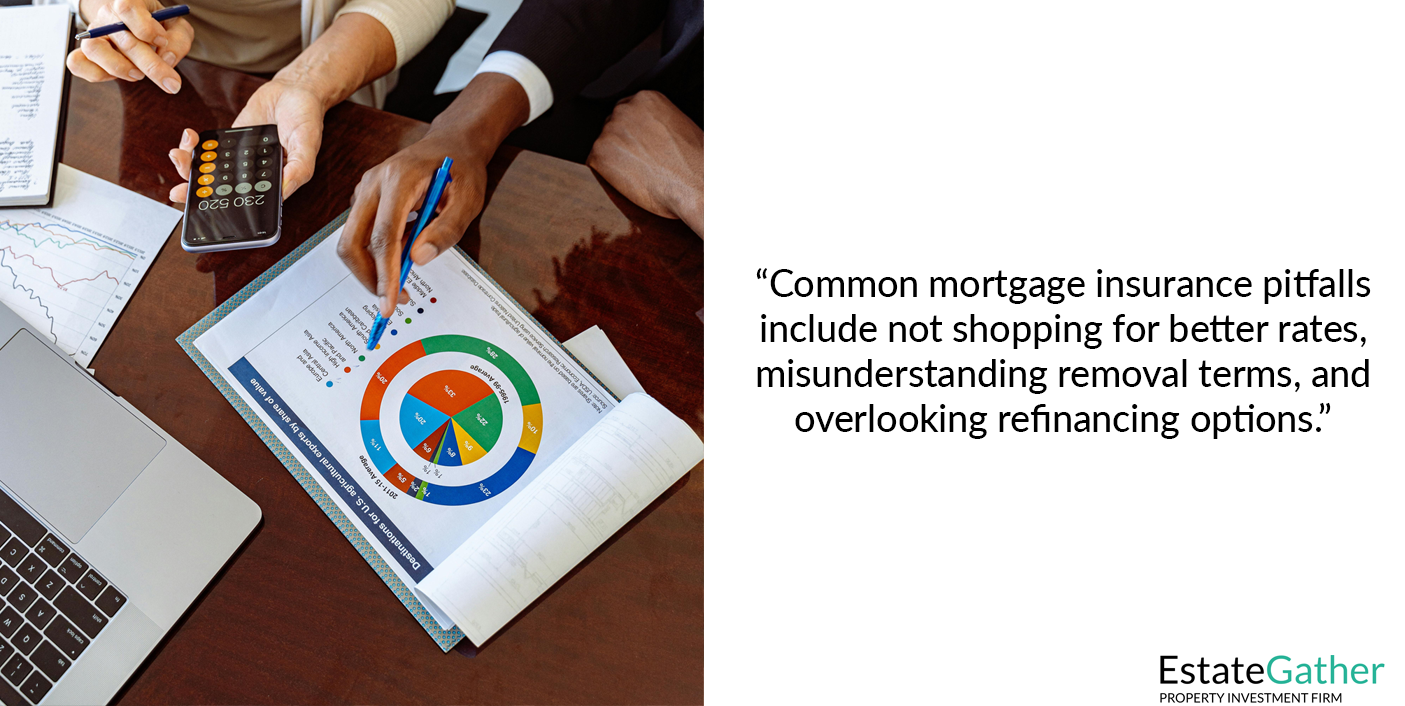Mortgage Insurance Premium
Mortgage insurance premiums (MIP) are an important consideration for homeowners, especially those who are planning to obtain a loan with a low-down payment. Understanding the ins and outs of MIP can help potential homebuyers make informed decisions and potentially save money over the life of their mortgage. Here’s an in-depth look at everything you need to know about mortgage insurance premiums.
KEY TAKEAWAYS
- Essential Protection for Lenders: Mortgage insurance premiums are primarily designed to protect lenders from the risk of borrower default, particularly in cases where the borrower makes a down payment of less than 20% of the home’s purchase price. MIP is particularly associated with FHA loans but is relevant to other low down payment loans as well.
- Variability in Costs and Requirements: The cost of MIP depends on several factors including the loan amount, loan-to-value ratio, the term of the loan, and the borrower’s credit score. For FHA loans, MIP includes both an upfront payment and an annual premium that is typically included in monthly payments. It’s crucial for borrowers to understand these costs and how long they will need to pay MIP, which can sometimes be for the life of the loan if less than 10% down payment is made.
- Opportunities for MIP Removal and Cost Reduction: While FHA loans require MIP regardless of the down payment amount, the conditions under which MIP can be removed vary. If more than 10% is put down, MIP can be removed after 11 years. In contrast, PMI on conventional loans can often be canceled once the borrower’s equity reaches 20% of the home’s value. Furthermore, making larger down payments and improving one’s credit score can potentially reduce the costs associated with MIP.
What is Mortgage Insurance Premium (MIP)?
Mortgage insurance premiums are fees that borrowers must pay when they take out a mortgage with a down payment that is less than 20% of the home’s purchase price. MIP is designed to protect lenders in case the borrower defaults on the loan. It is most commonly associated with loans backed by the Federal Housing Administration (FHA), but it can also apply to other types of low-down payment loans.

Types of Mortgage Insurance
- FHA Loans: MIP is required for all FHA loans, regardless of the size of the down payment. FHA MIP includes an upfront premium (UFMIP) which is usually 1.75% of the base loan amount, and an annual premium that varies based on the LTV ratio, loan term, and loan amount.
- Conventional Loans: Private mortgage insurance (PMI) is the equivalent of MIP for Conventional Loans. PMI rates are influenced by the down payment amount and the borrower’s credit score.
- USDA Loans: United States Department of Agriculture (USDA) loans require a guarantee fee, both at the time of closing and as an annual fee.
- VA Loans: Guaranteed by the Department of Veterans Affairs, Veterans Affairs (VA) loans do not require mortgage insurance, but they do require a funding fee based on the loan amount, type of veteran, and number of uses of the benefit.
Sponsor
YOUR
ADVERTISEMENT
HERE
Just $20 a Month, for full site coverage.

How is MIP Calculated?
The cost of MIP typically depends on several factors:
- Loan Amount: The higher the loan amount, the higher the MIP.
- Loan-to-Value Ratio (LTV): This ratio measures the relationship between the loan amount and the value of the property. A higher LTV ratio typically results in higher premiums.
- Loan Term: The length of the loan can affect MIP rates. Longer-term loans might have higher MIP rates.
- Borrower’s Credit Score: Some plans may adjust MIP rates based on the borrower’s creditworthiness.
Loan-to-Value Calculator

MIP is usually expressed as a percentage of the loan amount and is often incorporated into the monthly mortgage payment.
How to Remove MIP
The process to remove MIP from your mortgage payment varies depending on the type of loan:
- FHA Loans: MIP cannot be canceled on most FHA loans unless you put at least 10% down, in which case MIP can be removed after 11 years. For loans with less than 10% down, MIP remains for the life of the loan.
- Conventional Loans: PMI can typically be removed once the LTV ratio reaches 78% based on the original value of the property, or you can request its removal at 80% LTV.
Tax Implications and Deductions
MIP payments were previously tax-deductible under certain conditions, but this policy can vary based on federal tax law changes. It is important for borrowers to consult with a tax professional to understand current tax rules regarding MIP.
MIP Examples
Example 1: FHA Loan with Minimum Down Payment
Scenario:
- Home Purchase Price: $250,000
- Down Payment: 3.5% ($8,750)
- Loan Amount: $241,250
- Loan Term: 30 years
- MIP Rate (Annual): 0.85% (typical for loans with less than 5% down)
Calculation:
- Upfront MIP: 1.75% of loan amount = $4,221.88 (usually financed into the loan)
- Annual MIP: 0.85% of loan amount = $2,050.63
- Monthly MIP Payment: $2,050.63 / 12 = $170.89
Outcome: The borrower will pay an initial $4,221.88 in upfront MIP, which increases the total loan amount to $245,471.88. Additionally, the monthly mortgage payment will include $170.89 towards MIP.
Example 2: FHA Loan with Higher Down Payment
Scenario:
- Home Purchase Price: $200,000
- Down Payment: 10% ($20,000)
- Loan Amount: $180,000
- Loan Term: 30 years
- MIP Rate (Annual): 0.80% (for higher down payments)
Calculation:
- Upfront MIP: 1.75% of loan amount = $3,150 (usually financed into the loan)
- Annual MIP: 0.80% of loan amount = $1,440
- Monthly MIP Payment: $1,440 / 12 = $120
Outcome: In this scenario, the borrower also pays an upfront MIP of $3,150, increasing the total loan amount to $183,150. The monthly MIP payment would be $120, and because the down payment was 10%, the MIP can be cancelled after 11 years, unlike the typical scenario where MIP continues for the life of the loan.
MIP Annual Premium Calculator

Sponsor
YOUR
ADVERTISEMENT
HERE
Just $20 a Month, for full site coverage.

Common MIP Mistakes
1. Not Shopping Around for Better Rates
Investors sometimes accept the first mortgage offer they receive without shopping around. This can be a costly mistake, especially when it comes to mortgage insurance rates and terms, which can vary significantly between lenders.
Solution: Always compare mortgage offers from multiple lenders. This includes looking at the costs of PMI or MIP, interest rates, and other fees. Different lenders might also have different policies regarding how quickly you can remove PMI based on home value appreciation or principal repayment.
2. Misunderstanding the Terms of Mortgage Insurance Removal
Some borrowers assume that mortgage insurance will automatically drop off once they reach 20% equity in the home, but this is not always the case, especially with FHA loans.
Solution: Understand the specific criteria for canceling mortgage insurance on your loan. For FHA loans, you might be required to pay MIP for the life of the loan if you make a minimum down payment. For conventional loans, familiarize yourself with the conditions under which you can request PMI removal and when it is automatically terminated.
3. Overlooking Upfront MIP Costs
In FHA loans, the upfront MIP can be substantial and is often financed into the loan amount, which increases the total amount borrowed and the overall interest paid over the life of the loan.
Solution: Consider the financial implications of adding the upfront MIP to your loan balance. It might be beneficial to pay this fee upfront if possible to avoid paying interest on it for the duration of the loan.
4. Failing to Consider Refinancing Options
Borrowers with FHA loans often continue paying MIP for a long period without considering refinancing into a conventional loan, which might offer the possibility to remove mortgage insurance sooner.
Solution: Regularly review your mortgage and home equity situation to see if refinancing could be beneficial. If your credit score has improved and your home equity has increased, refinancing into a conventional loan might save you money on mortgage insurance and interest.
5. Not Factoring Mortgage Insurance into Overall Home Affordability
Some investors focus solely on the mortgage payment excluding the MIP/PMI and fail to consider how this additional cost affects their total monthly housing expense.
Solution: Always include the cost of mortgage insurance when calculating monthly housing expenses. This will give you a more accurate picture of what you can truly afford and prevent financial strain down the road.
6. Ignoring Tax Implications
Previously, mortgage insurance premiums were tax-deductible under certain conditions, but tax laws change frequently. Assuming these conditions always apply can lead to unexpected tax liabilities.
Solution: Stay updated on current tax laws and consult with a tax professional to understand how they apply to your mortgage insurance payments. This will help you budget more accurately and possibly save money.
By being aware of these common pitfalls and actively working to avoid them, investors can manage their mortgage insurance costs more effectively and make smarter financial decisions in the home buying process.

Mortgage insurance premiums add to the cost of purchasing a home but provide important protection for lenders. By understanding how MIP works and exploring options to minimize or eliminate these costs, borrowers can make more strategic decisions regarding their home financing. Whether you are a first-time homebuyer or looking to refinance, it’s crucial to consider how MIP will impact your financial situation and overall mortgage affordability. Knowledge about when and how MIP can be removed, or how the rates might vary based on your down payment and credit score, empowers you to plan better financially and potentially negotiate more favorable loan terms.
Frequently Asked Questions (FAQ)
What is Mortgage Insurance Premium (MIP)?
Mortgage Insurance Premium is an insurance policy used in FHA loans to protect lenders from the risk of default and foreclosure. It includes an upfront payment at the time of purchase and an annual premium that is paid monthly.
Why do I need to pay MIP?
If you take out an FHA loan and your down payment is less than 20% of the home’s purchase price, you are required to pay MIP. It provides financial protection to the lender in case you fail to repay the loan.
How is MIP different from PMI?
MIP is specifically for FHA loans and is required regardless of the down payment amount, whereas PMI is for conventional loans and only required when the down payment is less than 20%. MIP generally stays in place for the life of the loan if the down payment is less than 10%, while PMI can be removed once equity reaches 20%.
Can MIP be removed from my FHA loan?
For FHA loans issued after June 2013, if you put down more than 10%, MIP can be removed after 11 years. However, if your down payment is less than 10%, MIP cannot typically be removed and remains for the life of the loan.
How much does MIP cost?
The upfront MIP is usually 1.75% of the loan amount, which can be financed into the mortgage. The annual MIP rate varies, generally ranging from 0.45% to 1.05% of the loan balance, paid monthly.
Can I finance the upfront MIP?
Yes, the upfront MIP can be financed into the total loan amount. This means you don’t have to pay it out of pocket at closing, but it will increase the overall loan amount and the total interest paid over the life of the loan.
What factors affect the cost of MIP?
The main factors that determine the cost of MIP include the loan amount, the loan-to-value ratio (LTV), the term of the loan, and the borrower’s credit score.
How can I reduce the cost of MIP?
Making a larger down payment can reduce the duration MIP is required and potentially lower the annual premium. Additionally, refinancing from an FHA loan to a conventional loan might eliminate the need for mortgage insurance, depending on your home’s equity and other qualifying factors.
What happens if I refinance my FHA loan?
If you refinance your FHA loan to another FHA loan, you might be eligible for a partial refund of the upfront MIP paid on the original loan, depending on how long the original mortgage was in place before refinancing.

